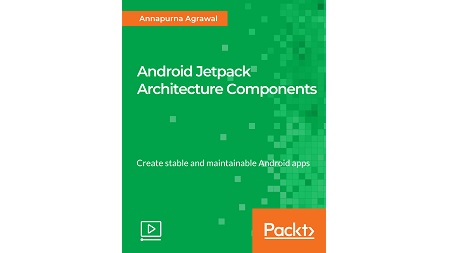
English | MP4 | AVC 1920×1080 | AAC 48KHz 2ch | 2h 53m | 505 MB
Utilize Android Jetpack Architecture components to make your Android application development flexible and maintainable
Programming Android apps can be a complex process and a lack of knowledge about architecting your apps can result in spaghetti code and dead-ends. In order to deliver an extendable, maintainable, and testable codebase, you have to think about the architecture of your application from the very first stage of its development.
This course will show you all new Android Jetpack Architecture components and features. You will develop Android applications by making use of all the architecture components available with Jetpack to reduce bugs in your codebase and provide seamless and smooth application development. Adding architectural components to your projects will increase their scalability and reduce code bugs.
By the end of the course, you will know how to use Jetpack to manage background tasks, navigation, paging, life-cycle management, and much more.
This course is divided into clear chunks so you can learn at your own pace and focus on your own area of interest
What You Will Learn
- Get introduced to Android architecture components
- Use the Data Binding library to bind data to the UI
- Provide stability in your app by handling life cycles, view models, and live data
- Implement effective in-app navigation by using the Navigation architecture component
- Load data gradually and gracefully in Recycler View by using the Paging library
- Implement a local database to store structured data by using the Room database
- Explore how to perform CRUD operations in the Room database
- Schedule tasks asynchronously by using Work Manager
Table of Contents
Getting Started with Architecture Components
1 The Course Overview
2 Why Architecture Components
3 Adding Components to Your Project
Exploring Data Binding Library
4 Understand Data Binding
5 Layouts and Binding Expressions
6 Work with Observable Data Objects
7 Loading Images from a URL Using Glide
Lifecycle-Aware Components, ViewModel, and LiveData
8 Lifecycle-Aware Components
9 Lifecycle-Aware Components Demo
10 Using ViewModel
11 Using ViewModel Demo
12 Implementing LiveData
Implementing the Navigation Architecture Component
13 Introduction
14 Implement the Navigation Architecture Component
15 Update UI Components with NavigationUI
16 Navigate Using Actions
17 Pass Data between Destinations Using SafeArgs
Exploring Paging Library
18 Understanding Paging Library
19 Set Up Backend API
20 Create PagedListAdapter and DataSource
21 Construct Observable List and Populate UI
Diving into Room Database
22 Introduction and Setup
23 Add Components of Room
24 Perform Insert Operation
25 View Database from Android Studio
26 Write Queries to Fetch and Display Data
27 Perform Update Operation
28 Perform Delete Operation
Scheduling Tasks with WorkManager
29 Why WorkManager
30 Implementing WorkManager to Schedule Tasks
31 Running Tasks Under Specific Conditions
32 Working with Input Parameters and Return Values
33 Next Steps
Resolve the captcha to access the links!